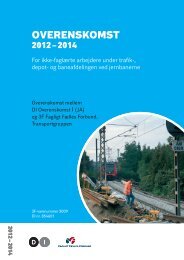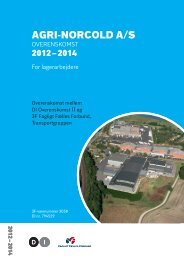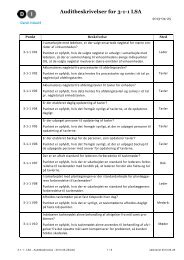Hydrogen and its competitors, 2004
Hydrogen and its competitors, 2004
Hydrogen and its competitors, 2004
Create successful ePaper yourself
Turn your PDF publications into a flip-book with our unique Google optimized e-Paper software.
Risø Energy Report 3<strong>Hydrogen</strong> infrastructure 535.6systems can achieve very high overall efficiencies, <strong>and</strong>due to the modular nature of fuel cell technologies theycan be configured to be distributed, centralised oranywhere in between.Robust hydrogen supply infrastructure solutions for roadtransport are needed urgently. Prototype hydrogenbasedfuel cell vehicles are already being tested <strong>and</strong>demonstrated in Europe, Japan <strong>and</strong> the USA, <strong>and</strong> somemajor automotive manufacturers have announced thatthey will market fuel cell vehicles already by 2005.Large numbers of hydrogen vehicles, however, are notexpected before 2015-20. Considerable efforts are beingmade to develop infrastructure solutions to supportthese vehicles, both through national R&D <strong>and</strong> demonstrationprogrammes <strong>and</strong> by the car industry. Theaccelerating development of hydrogen vehicles brings anurgent need for common codes, st<strong>and</strong>ards <strong>and</strong> regulations.Filling stations for pressurised hydrogen gas are expectedto be an essential part of an initial infrastructure.<strong>Hydrogen</strong> stored as a compressed gas at up to 700 baralready gives today's vehicles a range comparable to thatof conventional vehicles, whereas infrastructures tosupport liquid hydrogen, metal hydride <strong>and</strong> otherstorage methods are not seen as viable at the moment.Road maps presenting the shorter-term aims <strong>and</strong> strategiesfor introduction of hydrogen for transport generallyagree on the steps towards an extended hydrogen infrastructure.First, hydrogen filling stations will be built inlarge cities to supply bus fleets <strong>and</strong> other vehicles inregular operation within a limited area. A single fillingstation in a densely-populated area can serve a largenumber of users <strong>and</strong> maximize the environmental <strong>and</strong>health benef<strong>its</strong> of hydrogen. This is an optimal way toincrease public awareness <strong>and</strong> acceptance of hydrogentechnology.Step two is to build filling stations on major roadslinking cities <strong>and</strong> large towns that already have theirown hydrogen filling stations. This allows existing fleetsof hydrogen vehicles to increase their range, <strong>and</strong> willhelp to increase the size of the hydrogen vehicle market.<strong>Hydrogen</strong> infrastructure <strong>and</strong> future supplyoptionsThe relevant hydrogen production options to supply thenetwork of filling stations much depend on the local orregional conditions. In an initial stage the hydrogenproduction <strong>and</strong> supply may take advantage of theexisting infrastructure for electricity <strong>and</strong> natural gas.Via electrolytic production hydrogen may be generated<strong>and</strong> supplied at almost any location. The modularity ofthe electrolysis technologies means that both large <strong>and</strong>small-scale plants may be relevant. The individualhydrogen filling stations may be equipped with electrolysisun<strong>its</strong>, e.g. for high-pressure electrolysis, compressor<strong>and</strong> storage facilities, <strong>and</strong> dispensers for high-pressurehydrogen. Even very small-scale residential dispenserun<strong>its</strong> may be a future option based on electrolysis.Producing hydrogen via electrolysis means that attributesof the power production system in question e.g.primary energy inputs <strong>and</strong> CO 2 characteristics, partly aretransmitted to the transport sector. Fuel flexibility <strong>and</strong>system development options for the overall powersystem become options for transport as well.Where natural gas is available, reforming is anothersupply option for hydrogen. Reformer plants could besituated near, or in, hydrogen filling stations. Economiesof scale, however, may favour larger reformer plants,which in turn would require local pipelines to supply thefilling stations.Beyond the very initial stages of a hydrogen supplyinfrastructure build-up another option may be todistribute hydrogen mixed into the NG-grid in quantitiesup to about 15% volume, depending on pipelinematerial, pipeline pressure <strong>and</strong> end user technology.<strong>Hydrogen</strong> supplied from numerous sources may bedistributed via mixed gas grid lines.<strong>Hydrogen</strong> filling stations would be able to separate thehydrogen from the natural gas, purify <strong>and</strong> pressurise itfor use in vehicles. Most other users would simply be ableto burn the natural gas/hydrogen mixture without problems.The only difficulties would be with internalcombustion engines running on natural gas. Denmarkhas many such engines in small CHP stations, <strong>and</strong> it hasbeen shown that hydrogen levels above 1-2% in the gascan cause operational problems or reduced output. Newengines developed for natural gas/hydrogen blendsshould not suffer from these problems.Various other factors also limit the proportion ofhydrogen than can be added to natural gas pipelines. Theneed to preserve the combustion quality of the gas(Wobbe index) would limit the hydrogen content to 25%by volume, while restrictions on density would allow amaximum of 17% hydrogen. The most stringent limit isset by leakage <strong>and</strong> material compatibility. Above about15% hydrogen, problems of leakage, corrosion, degradationof polyethylene pipe <strong>and</strong> embrittlement of steels areexpected [8]. Tests <strong>and</strong> analyses of using the Danish NGgridfor transporting medium-pressure pure hydrogenhas been carried out during 2003 [15]. Results of this testcarried out during one year indicate that materialchanges may take place in the 4 bar distribution grid.Leakage measurements show that connections <strong>and</strong> sealingsmust be checked more frequently than for naturalgas.The energy content of hydrogen is only around onethirdthat of the same volume of natural gas. As a consequence,pipelines <strong>and</strong> underground storage caverns forhydrogen would have to be three times the size of theirnatural gas equivalents, at the same pressure, to coverthe same energy dem<strong>and</strong>. For safety reasons, hydrogenpipelines will also operate at lower pressures than natural
















